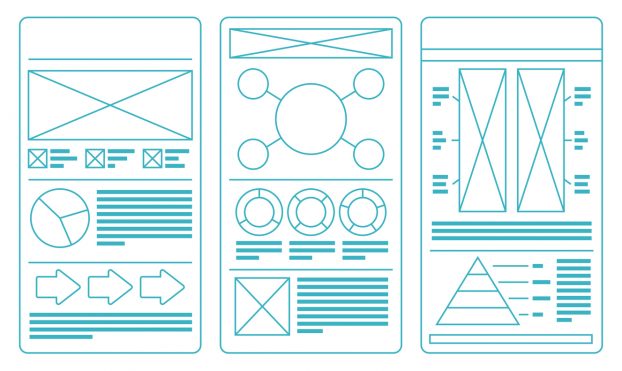Wireframes in Simple Terms
Semgeeks helps businesses and designers effectively communicate design concepts and expectations by providing wireframing services. Our expert team creates detailed wireframes that showcase the flow and layout of your design, ensuring a smooth and efficient design process. With Semgeeks, you can set clear expectations, streamline collaboration, and create visually stunning designs that align with your vision.
Imagine wireframes as the building plan for websites and apps. They’re like a rough sketch showing where everything goes. Think of them as a GPS for designers, helping them figure out how things should be arranged before making them look pretty. The wireframe — is also known as a page schematic or screen blueprint, and it is a visual guide that represents the skeletal framework of a website or an application.
Wireframes are super useful for designers because they help plan how users will move around, where buttons and menus go, and where content should be placed. This way, designers can create websites and apps that are easy for people to use.
One cool thing about wireframes is that they allow designers to get feedback from clients and bosses early on. This means they can fix things before spending lots of time and money on the final design.
So, in a nutshell, wireframes are like the secret recipe for making great websites and apps, making sure everyone on the design team is on the same page and working towards the same goals.
Why Wireframes Matter
Wireframes are like design wizards’ secret spells, conjuring up all sorts of benefits for both designers and clients. Here’s why they’re pure magic:
1. Crystal Clear Direction: Wireframes are like treasure maps that guide designers through the design journey. They show exactly where things should go, setting clear expectations.
2. Early Problem Solvers: Think of wireframes as superheroes with X-ray vision. They help designers spot potential challenges before they become big headaches, saving time and money.
3. User-Focused Magic: user experience. They make sure that how users interact with a website or app is smooth and easy, even before the fancy visuals come into play.
4. Valuable Feedback Magnet: They’re like magnets for valuable client feedback. Clients can easily understand and comment on the design when it’s presented as wireframes.
5. Streamlined Design: Wireframes are like the blueprint of a house. They help designers build a functional and visually pleasing product that matches the client’s vision.
Wireframes: Teamwork Made Easy
Wireframes are like the superhero sidekick for design and development teams. They swoop in to save the day by making teamwork smoother and more effective. Here’s how they do it:
1. Visual Clarity: Wireframes act like a common language that everyone in the team speaks. They visually represent the project’s design and functionality, making it easy for everyone to understand and discuss it.
2. Shared Vision: Imagine wireframes as blueprints for a house. They give the whole team a clear picture of how things should be arranged, from navigation bars to menus. Designers, developers, project managers, and others all see the same plan.
3. Expectation Setting: Wireframes are like the team’s GPS. They set expectations for how the design will flow and look. This common reference point ensures that everyone is on the same page and reduces misunderstandings.
4. Smoother Collaboration: Wireframes make teamwork a breeze. Team members can work together to refine design ideas, provide feedback on the user experience, and make informed decisions. This saves time and prevents unnecessary do-overs.
Wireframes: The Design Toolkit
Wireframes are like tools in a designer’s toolkit, and they come in different types, each with its own superpower.
1. Low-Fidelity Wireframes: Think of these as your rough sketches. They’re quick and simple, focusing on the basic layout and structure of a design. Perfect for brainstorming and initial ideas.
2. High-Fidelity Wireframes: These are like detailed blueprints. They’re more complex and include actual content and visuals, closely resembling the final product. Great for getting client feedback and making the design feel real.
3. Digital or Interactive Wireframes: These wireframes are like prototypes. They’re created using digital tools and can even have interactive elements like buttons or menus. Super useful for testing and refining the user experience.
Each type of wireframe has its own role in the design process, from early brainstorming to fine-tuning the final product. Designers choose the right type based on the project’s needs. Wireframes are the ultimate design Swiss Army knife!
The good news is that today we have a wide range of simple but very powerful tools like Figma, Invision, Adobe XD, UXPin, Axure, Moqups, etc. and we definitely need to review them and choose the best tool for designing the wireframes and developing simple prototypes.
Setting the Stage for Effective Wireframes
Before diving into the world of wireframes, there are a few things to get in order to ensure they hit the mark:
1. Crystal-Clear Design Goals: Start by knowing exactly what the design should achieve. Who’s the audience? What’s the website or app’s purpose? Any specific requirements? These goals set the path for your wireframes.
2. User Research is Key: Understand your audience inside out. What do they like? What do they need? Conduct surveys, interviews, and usability tests to gather these insights.
3. Plan the Information Architecture: Before putting pen to paper (or cursor to screen), organize and structure your content logically. Think about how users will navigate through it. This sets the backbone for your wireframes.
4. Communication is King: Keep the lines of communication wide open with your design team, stakeholders, and clients. Everyone should be on the same page throughout the wireframing journey.
By nailing these prerequisites, you’ll be well-prepared to create wireframes that not only set the stage for design but also lead to successful projects. Wireframes are your blueprint for success!
Semgeeks helps businesses and designers effectively communicate design concepts and expectations by providing wireframing services. Our expert team creates detailed wireframes that showcase the flow and layout of your design, ensuring a smooth and efficient design process. With Semgeeks, you can set clear expectations, streamline collaboration, and create visually stunning designs that align with your vision.

